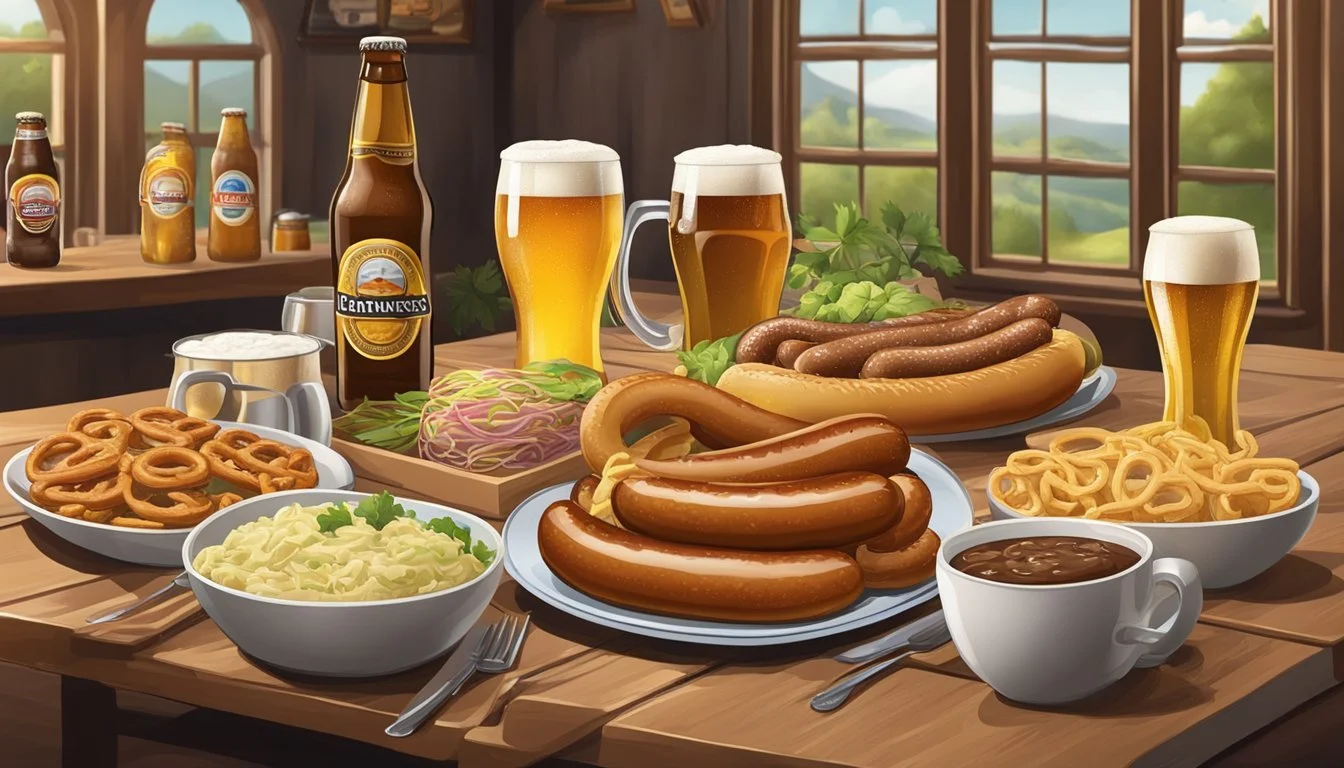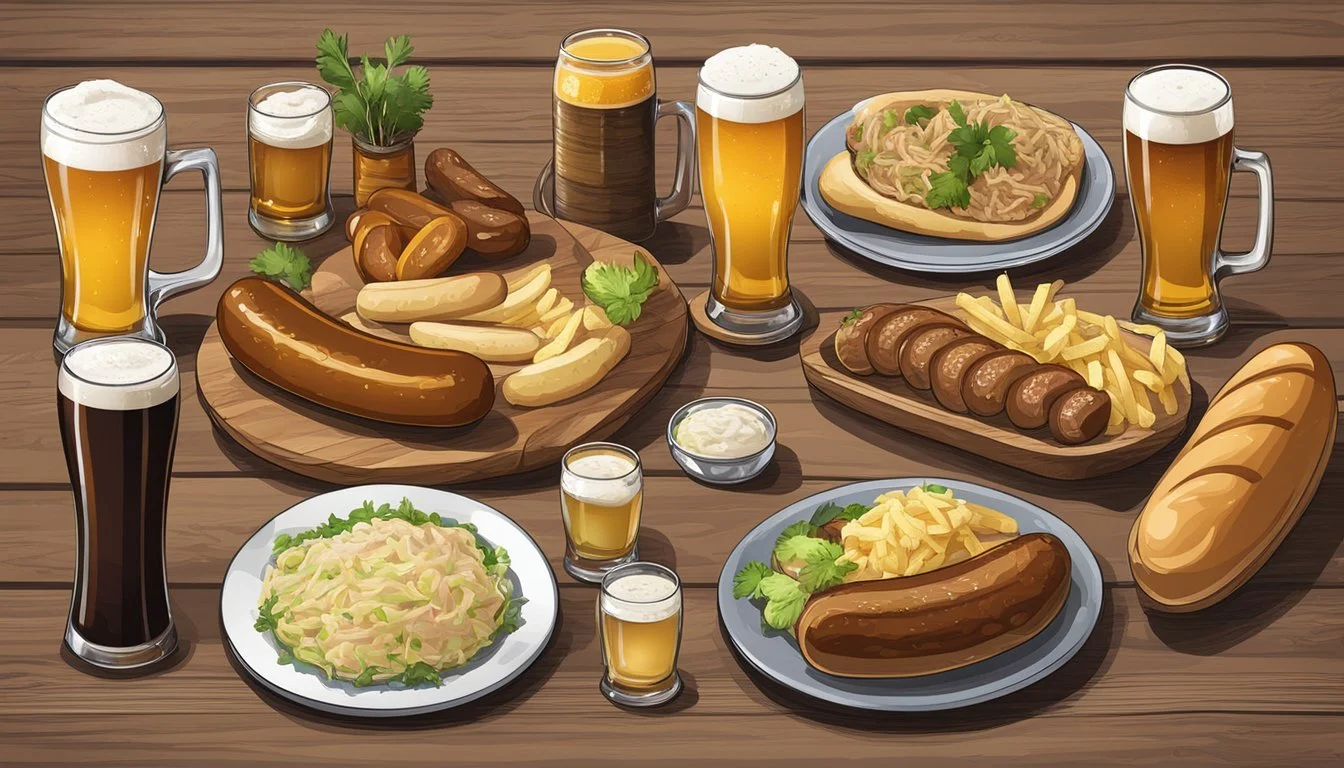German Texan Food and Beer Pairings
A Guide to Perfect Combinations
The fusion of German and Texan cuisines creates a unique and thrilling gastronomic landscape, and with the right beer pairings, the experience is heightened to new levels. German settlers brought with them a rich tradition of brewing and culinary expertise when they arrived in Texas, integrating their flavors with the local fare. This culinary marriage has birthed dishes that carry a distinct German influence while embodying the bold spirit of Texan cuisine. The challenge and delight lie in finding the perfect brew that complements these robust, hearty meals—a task that engages the senses and elevates both the food and the beer.
Beer pairing is both an art and a science, and in the context of German Texan food, the synergy between a dish and its accompanying beer hinges on finding balance. The malty sweetness of a Märzen or the crispness of a German-style lager can cut through the richness of smoked brisket or sausages. In turn, the spiciness of Texan rubs and seasonings can be tempered by the subtle hoppiness or the wheat profile of a Hefeweizen.
With a confident grasp of the flavors at play, one can navigate this cross-cultural culinary scene with confidence. It requires an understanding of the depth of flavor in traditional German dishes, such as schnitzels and potato salads, and the boldness of Texan barbecue, where-smoked and grilled meats dominate the table. Selecting beers with complementary flavor profiles—be it a robust Dunkel or a tangy Berliner Weisse—can enhance the dining experience, showcasing how German brewing heritage and Texan culinary bravado can triumph on the same table.
The History of German Influence in Texas
German settlers began arriving in Texas during the early 19th century. They, attracted by the promise of land grants in the Lone Star State, migrated in significant numbers and established tight-knit communities. Notably, towns like Fredericksburg, New Braunfels, and San Antonio in the Texas Hill Country region still bear evidence of this heritage.
In 1845, Prince Carl of Solms-Braunfels led a group of German settlers to found the town of New Braunfels, infusing the area with German traditions. Similarly, Fredericksburg was established by German immigrants in the same year, named in honor of Prince Frederick of Prussia.
The impact of German migrants extended to Texas's capital as well, with Austin incorporating various aspects of German culture into its local customs. These communities became centers for maintaining and celebrating German heritage through festivals, music, and, notably, food and beer.
Notable German-Texan Towns Fredericksburg New Braunfels San Antonio
By the 1850s, the German-born population in Texas had doubled to around 20,000, peaking in the late 19th century. They introduced a range of culinary traditions, significantly shaping the Texan food landscape with their sausage-making skills and other gastronomic practices. Their influence also extended to brewing, leaving an everlasting mark on Texas beers.
German Festivals: Wurstfest in New Braunfels celebrates sausages and beer, drawing large crowds annually.
Culinary Contributions: German immigrants brought sausage-making skills, contributing to Texan cuisine.
German Texans, preserving their unique ethnicity, amalgamated their old-world customs into the fabric of Texas society, resulting in a cultural synthesis still observed today.
Fundamentals of German-Texan Cuisine
German-Texan cuisine is a rich tapestry woven from traditional German recipes and the Lone Star State's bountiful ingredients. From sausages to sauerkraut, the German influence is undeniable and steadfast.
Sausage Varieties:
Bratwurst: A blend of pork and veal, well-spiced.
Texas Hot Gut: A smoky, Czech-inspired local favorite.
When it comes to bread, the iconic pretzels retain their twisty charm, while strudel speaks to the love for fruits like apples, commonly found in desserts. The savored schnitzel, particularly the pork schnitzel (What wine goes well with pork schnitzel?), is a perfect testament to the German preference for pork, often accompanied by red cabbage or sweet-and-sour cabbage.
Side Dishes:
Potato Pancakes: Crispy, with a hint of onion.
Käsespätzle: The German mac and cheese, gooey with beer cheese.
Texas's pride, BBQ, integrates effortlessly with German methodical cooking, leading to mouth-watering mergers of smoky and tangy flavors. Sauerkraut, with its tartness, often cuts through the rich meats, offering a refreshing balance.
Desserts and Baking:
Apple Cake: Dense and moist, laced with cinnamon.
German Onion Pie: An aromatic blend of onions and custard in a flaky crust.
In terms of beverages, beer is more than a casual refreshment—it's a cultural cornerstone pairing with meals. German styles such as Märzen and Dunkel enhance the robust flavors of the meats and sides alike.
Each dish and pairing within German-Texan cuisine invite a journey through a fusion of culinary worlds—one where meticulous German craftsmanship meets the hearty comfort of Texan cooking.
Introduction to German Beers
German beers have a storied history and a reputation for excellence, due in part to the country's purity law, Reinheitsgebot, which dates back to 1516. This law ensures that only water, hops, malt, and yeast are used in the brewing process, promoting purity and quality. Various styles of German beers, each distinct in taste and origin, have made their way into beer gardens and tables across the world, often accompanying traditional German foods.
Popular German Beer Styles and Characteristics:
Pilsner: A type of pale lager that offers a clear golden color, crisp flavor, and a balanced hoppy bitterness.
Weissbier: Also known as Weizenbier, this wheat beer is light in color and features a notable yeast presence, with hints of banana and clove.
Märzen: Brewed in March and left to age through the summer, this beer is an Oktoberfest staple. Märzen is characterized by its rich amber color and toasty malt flavors.
Helles: A pale lager that's brighter and slightly sweeter than a Pilsner, Helles is known for its drinkability and subtle hops.
Amber Lager: Generally malt-forward, offering caramel notes and a medium body.
Kölsch: A crisp, light beer traditional to Cologne with a delicate balance of malt and hops.
Darker styles include:
Dunkelweiss: A darker variety of wheat beer with the same fruity flavors as Weissbier, complemented by caramelized malts.
Schwarzbier: Literally 'black beer', this style is surprisingly light-bodied with flavors of chocolate and coffee.
Vienna Lager: Known for its reddish-amber color and slightly sweet malt profile with a clean, crisp finish.
Altbier: This 'old beer' style hails from Düsseldorf and is fermented at cooler temperatures, giving it a clean, lager-like character with a more pronounced bitterness.
In a sociable beer garden or during a festive Oktoberfest celebration, it’s common to hear the cheery exclamation "Prost!"—the German equivalent to "Cheers!"—as friends raise their glasses. Germany’s variety of beers offers a symphony of flavors, which when thoughtfully paired with food, can enhance the culinary experience for any lover of German fare.
Classic German-Texan Food and Beer Pairings
In the fusion of German and Texan cuisines, the pairing of flavorful dishes with complementary beers creates a harmonious dining experience. Here, the focus is on traditional recipes and the art of matching them with the right brew.
Schnitzel and Lager
Thin, breaded, and fried pork or veal Schnitzel pairs exceptionally with a crisp, light Lager. The beer's clean taste cuts through the richness of the meat.
Bratwurst and Märzen
Bratwurst stewed with Sauerkraut finds its match in the festive Märzen. This Oktoberfest beer, with its toasty malt flavors, complements the savory notes of the sausage.
Bavarian Pretzels and Weissbier
Hearty Bavarian Soft Pretzels served with traditional beer cheese dip are best enjoyed with a frothy Weissbier. The beer's hint of banana and clove elevates the simple pretzel.
Apple Strudel and Helles
Delight in Apple Strudel paired with a refreshing Helles. The gentle maltiness and subtle hops of the helles balance the sweetness of the strudel.
BBQ and Amber Lager
Smokey Texan BBQ, especially pork shoulder or pork loin, pairs with a robust German Amber Lager. The lager's caramel notes harmonize with the smokiness of the meat.
Potato Pancakes and Kölsch
Potato Pancakes, crisp on the outside and tender inside, are complemented by the light, fruity Kölsch. This pairing is a nod to Germany's Rhineland.
Schweinshaxe and Dunkelweiss
Schweinshaxe, a tender pork knuckle, is ideally savored with Dunkelweiss. The beer's dark wheat malt profile echoes the pork's heartiness.
Pork Schnitzel and Altbier
Another variation of the schnitzel made with pork loin, Pork Schnitzel goes hand-in-hand with Düsseldorf's Altbier, a brew that offers a balance of hops and malts.
Braised Pork Chops and Vienna Lager
The subtle sweetness of Braised Pork Chops (What wine goes well with pork chops?) is a fine companion to the malty Vienna Lager. This lager enhances the caramelization of the pork.
Currywurst and Schwarzbier
Currywurst, a German sausage specialty doused in curry ketchup, pairs wonderfully with a dark Schwarzbier. The light body but roasted malt of the beer counterbalances the spiced sauce.
Cultural Significance of Food and Beer in German-Texan Celebrations
In German-Texan festivals, food and beer are more than mere sustenance; they are an embodiment of cultural identity and history. Oktoberfest and Wurstfest are prime celebrations where these elements are in full display. Oktoberfest, a nod to the wedding of Princess Therese, swells with vibrant marches and attendants clad in traditional lederhosen, toasting with cries of "Prost!" in energetic beer gardens.
Oktoberfest food pairings are carefully selected to complement the variety of beers. Rich, hearty flavors typically found on an Oktoberfest menu, such as bratwurst and pretzels, are enhanced by the robust maltiness of a Märzen lager.
Wurstfest, held annually in New Braunfels, celebrates the German sausage through a variety of dishes, from classic bratwurst to exotic wurst-influenced concoctions. Amid the lively strains of live music, the air is scented with grilling meats while hands hoist steins, creating an atmosphere of communal indulgence.
Dish Beer Pairing Bratwurst Märzen/Oktoberfest Lager Soft Pretzels German Pilsner Sauerbraten Doppelbock
For a more subdued experience, a Sunday Brunch can provide a gentler introduction to this culinary world with dishes like apple strudel or rye bread coupled with lighter ales or weissbier.
In the context of these events, brewing traditions from Germany form an inseparable pair with the gastronomy, each enhancing the other, creating an immersive journey through taste and time, a tradition deeply woven into the fabric of Texan society.
Exploring Local German-Texan Beer Gardens and Festivals
German-Texans have long celebrated their heritage, notably through food and beer festivals. These vibrant celebrations are scattered across the state, bringing a taste of German tradition to the Lone Star State.
Austin's German-Texan Establishments
In Austin, German-Texan culture thrives within local beer gardens. Scholz Garten, established by a German immigrant in 1866, stands as a testament to this legacy, flaunting a rich history intertwined with the city’s growth. This venue not only serves as a hub for the German community but also as a place where patrons can enjoy a wide selection of beers alongside traditional German fare.
Beer Culture: Lively, Historically Rich
Food Pairing: Bratwurst Sausages with Craft German-Style Beers
Fredericksburg's Culinary Delights
Fredericksburg, nestled in the Texas Hill Country, offers an authentic slice of German heritage. The quaint town prides itself on establishments like Pontotoc Vineyard Weingarten, which marries German food with locally made wines. Visitors can savor the harmonious pairing of bratwurst sausages, artisan breads, and boutique draft beers.
Specialty: Vintage Wines, Artisan Breads, Bratwurst Sausages
Atmosphere: Quaint, Authentic
San Antonio's German Beer Culture
San Antonio's affinity for German culture is reflected in its beer culture, with several beer gardens where one can enjoy German beer in a convivial setting. The beer gardens often feature live music, creating an atmosphere that pays homage to the traditional German Volksfest.
Live Music: Often Available, Enhances Experience
Beverage of Choice: German Beer
New Braunfels and Wurstfest
Lastly, New Braunfels hosts Wurstfest, the pinnacle of German-Texan festivals in the area, often attracting more than 100,000 visitors. Held in November, this ten-day salute to sausage is filled with authentic German food, music, and dance, spotlighting the cultural fusion of Texas and Germany.
Festival Dates: November - 10 Days
Highlights: German Food, Beer, Culture
Tips on Pairing Food and Beer Like a German Texan
In the fusion of German and Texan culinary traditions, beer pairings play a crucial role. A confident approach to combining flavors enhances the dining experience. When selecting a beer to accompany a dish, it is vital to consider the intensity and primary tastes of both the food and the beverage.
German Texan Dishes and Beer Pairings:
Sausage and Sauerkraut:
Pair with a Märzen or Dunkel to complement the savory notes and tanginess of the sauerkraut.
Chicken-fried Steak:
Opt for a Helles Lager or Pilsner; their crispness cuts through the richness of the gravy.
Enjoy with a Rauchbier for a smoky harmony or a bold Schwarzbier to match the robust meat flavor.
Pretzels:
An Altbier or Weissbier pairs well, balancing the saltiness with malt sweetness or wheat beer crispness.
Beer Pairing Tips:
A rule is to match strength with strength. Bold Texas BBQ requires beers with character, like Rauchbier, which echoes the smokiness of the meat.
Delicate dishes like potato salad merit a lighter beer such as Kölsch, which will not overpower the food’s subtle flavors.
For spiced foods such as Tex-Mex chili, a beer with a hint of sweetness like a Dunkelweizen can counterbalance the heat and spices effectively.
Pairing food and beer is an art that combines knowledge and confidence. Exploring German Texan cuisine with the perfect beer is a rewarding gastronomic journey. Remember, the goal is harmony between the plate and the pint.
Conclusion: Embracing the Fusion of Cultures
In the rich tapestry of Texan gastronomy, the German influence is unmistakable. German settlers brought with them robust flavors and distinct brewing techniques that, when paired with Texan fare, create a unique culinary experience.
German-Texan Food: The bold tastes of German cuisine (What Wine Pairs Perfectly With German Cuisine)- sausages, schnitzels, and pretzels - are elevated when matched with the deep, smokey flavors of Texas barbecue. A plate of smoked brisket is complemented by the tangy notes of sauerkraut, marrying two culinary worlds on a single platter.
German Beer: Integral to this fusion are the German beers that have permeated Texan culture. Whether it's a crisp Pilsner or a hearty Dunkel, these beers act as a palate cleanser, cutting through the richness of Texan meats and aligning splendidly with the spices of German dishes.
Pairings:
Brisket with Dunkel: The malty sweetness of a Dunkel pairs perfectly with the savory brisket.
Sausage with Pilsner: A light, refreshing Pilsner balances the spiciness of German sausages.
Their communal heritage shines through during festivals such as Wurstfest, where food becomes the medium of cultural exchange. This event epitomizes the harmony found in German-Texan cuisine - a true testament to the shared history and continued appreciation for the fusion of cultures. These pairings do not merely complement; they tell a story, creating a legacy that persists in every shared meal and clinked glass. The union of German beer and Texan food symbolizes a convergence of history, a delicious blend of the old world and the new.






